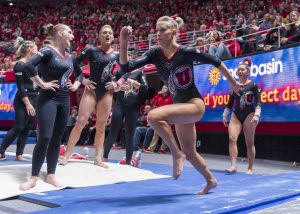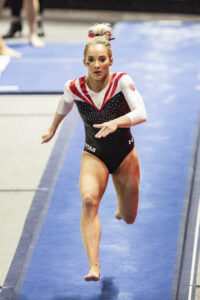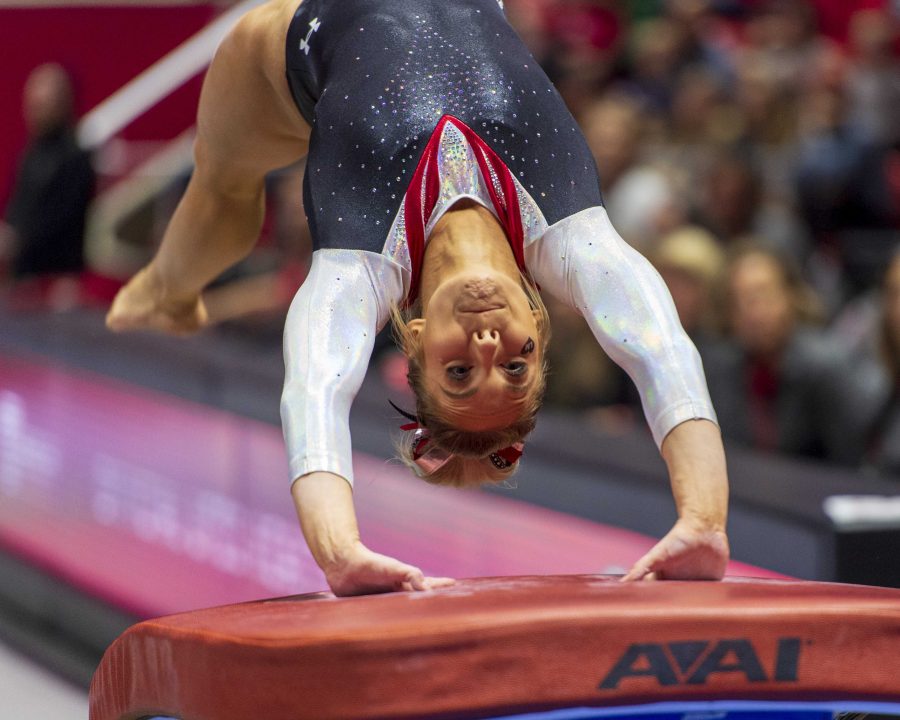There is more than meets the eye when it comes to gymnastics. It might look simple to an average fan, but there are a lot of things that go on behind the scenes. In most of its events, there are certain elements that a gymnast’s routine must have to be considered complete and lead to a perfect score. In this four-part series, each event will be broken down to the basics so fans who are learning or veteran fans who need a refresher will know what to look for in every gymnastics event.
Before we do that, let’s talk about scoring and skill levels in NCAA gymnastics.
Scoring: How does it work?
Gymnastics is one of the few sports where a gymnast can actually max out a score. The highest possible score that a team can get in a meet is 200, meaning that every gymnast on the team gets a perfect score of 10.0 in every single event.

(Photo by Kiffer Creveling | The Daily Utah Chronicle)
At the individual level, routines can start at any point level from 9.990-10.00, depending on difficulty. Deductions can be anywhere from a tenth of a point to a hundredth of a point or even full points, depending on what happens in the routine.
Things like taking a step on the dismount or flexing feet are some common errors which can lead to deductions.
Routines are usually scored by two judges who watch the routine and then scale it accordingly. The final score comes from averaging the two scores from the judges.
At the NCAA level, scores in the 9.7 range are considered okay and good for most programs. Routines in the 9.8s are average and 9.9s are great, but when someone gets a perfect score of 10, it can totally change the entire momentum of a meet.
Just like in most sports, judges have a tough job lined up for them when it comes to scoring routines. University of Utah Red Rocks gymnastics co-head coach Megan Marsden knows that the judges have a tough time, especially since scoring is subjective.
“The judges don’t have an easy job,” Marsden said. “They see it in real time, one time and they have to have all of that in their head and they have to quickly write the shorthand they use to come up with a score instantaneously.”
Skill level: What’s that?
Gymnastics is also unique in that each of the athlete’s move has a skill level. The easiest moves are labeled with an “A” and the hardest moves an “E.” According to Marsden, this is all laid out in the Code of Points, a book that describes what each move is and how it should be done properly to receive the point values. A-C skills are the base for most routines and don’t have point values in routines, so athletes must add D-E level skills for the boost in scores.
“Routines must be made up of a combination of those levels,” Marsden said. “You have to have three As, three Bs and two Cs, but none of those give you value, so then you have to have Ds and Es to get from a 9.5 to a 10.0 and most of the athletes at the top programs have many Cs, Ds and Es [routine elements] and if they have more than they need then they can count for the As and Bs because those are easy to cover.”
An example of an A-level skill is a full turn on the beam while Sydney Soloski’s double layout during her floor routine is an E, which gives her extra value in her routine.
Vault: Blink and You’ll Miss It
Vault is the fastest event in gymnastics, taking place in a matter of seconds. Unlike the other events in gymnastics, vault does not have any requirements that gymnasts must complete for their routine to be considered complete and to avoid point deductions. Instead, each specific vault has a predetermined start value. You might be asking, “What is a start value?” A start value is the starting score that judges can take deductions from.
Deductions in this event can come from obvious mistakes such as taking a step on the landing to something almost unnoticeable like bending the arms on the vaulting table. Other deductions can come from separating the legs while in the air or the coach spotting the gymnast during their routine.
Judges look for things like the distance that a gymnast lands away from the vault table, height off the vaulting table and good form during the vault as well as sticking the landing without taking any steps or hops forward or backward.
The Red Rocks have the honor of having the current NCAA Champion of the vault on their team. MyKayla Skinner currently holds the title on the event, scoring a 9.9375 in last year’s NCAA Championship in St. Louis. Her all-time high on the event is a whopping 9.975, which she has earned twice this season and once during the 2017 season.

(Photo by: Justin Prather | The Daily Utah Chronicle).
For Skinner, the way to achieve a great vault routine starts with the run down the mat. According to her, you don’t need to start off with an immediate sprint. Rather, slowly speed up until you hit the board.
“I think if you run too fast, everything gets rushed, and you don’t need that much power going into the vault,” she said.
The run isn’t the only thing that will lead to a strong performance. The punch a gymnast has on the board can make or break the vault.
“It requires you have a good punch on the board and getting the arms back for the takeoff. I mean Robert [Ladanyi] always tells me to punch more on the board with straight legs and get those arms back and block first before I twist,” Skinner said.
As to how one sticks the landing, it’s all about spotting.
“Definitely opening up and spotting for the landing is where you can try and get that stick,” Skinner said.
Since there are no required elements in a vault routine, deductions can seem to be a little nit-picky at times. According to Skinner, if a gymnast is clean and sticks the landing, the judges are going to have a harder time trying to find deductions.
One thing a lot of teams are pushing for now is for gymnasts to complete vaults that start out with a value of 10. Even though vaults at that level are harder than others, it gives the team a better chance to boost their score. Red Rock assistant coach Robert Ladanyi is the vault coach for the team and can see the appeal of making sure most of the vaults the team does start at the 10 level.
“In the end, the more of those you have, you can get a higher team score,” he said.
There are multiple possible vaults someone can do that start off at the 10 level. According to the NCAA rule book for collegiate gymnastics, there are over 70 options for vaults that start at that level. Skinner is known for doing a 10-valued vault and sticking the landing most of the time. The lowest value a vault can start at is an 8.8, which is the most basic version of most of the higher valued routines.
The vault is one of Skinner’s favorite events to compete in, so her preparation for the event comes as something she looks forward to when the team hits the event.
“Whenever I go to the floor and vault I get to have fun with it,” she said, “so approaching it, I go out there and I feel like I’m ready to go out there and just attack it, and be like ‘I’m going to show these judges, I’m going to stick it’ and show them what I’ve been working hard on.”
Skinner says it is important for her to be aggressive when hitting the board and just keep doing her thing.
Utah is one of the best teams in the country when it comes to the vault. The team currently has the second-best vault rotation in the country, right behind Oklahoma. Georgia is the third-best team in the country, and UCLA and LSU are tied for fourth.
Next week, we will swing on over to a fan favorite event: the uneven bars. The bars can be both entertaining and stressful for fans to watch, when the gymnasts are going from the low bar to the high bar and so on. Bars is the first event that not only has a set of elements that are needed, but also a time limit.




